Mumps in Kids Report 2022
VerifiedAdded on 2022/08/11
|9
|2645
|15
AI Summary
Contribute Materials
Your contribution can guide someone’s learning journey. Share your
documents today.

RUNNING HEAD: HEALTHCARE 0
Mumps in Kids March 4
2020
Mumps in Kids March 4
2020
Secure Best Marks with AI Grader
Need help grading? Try our AI Grader for instant feedback on your assignments.
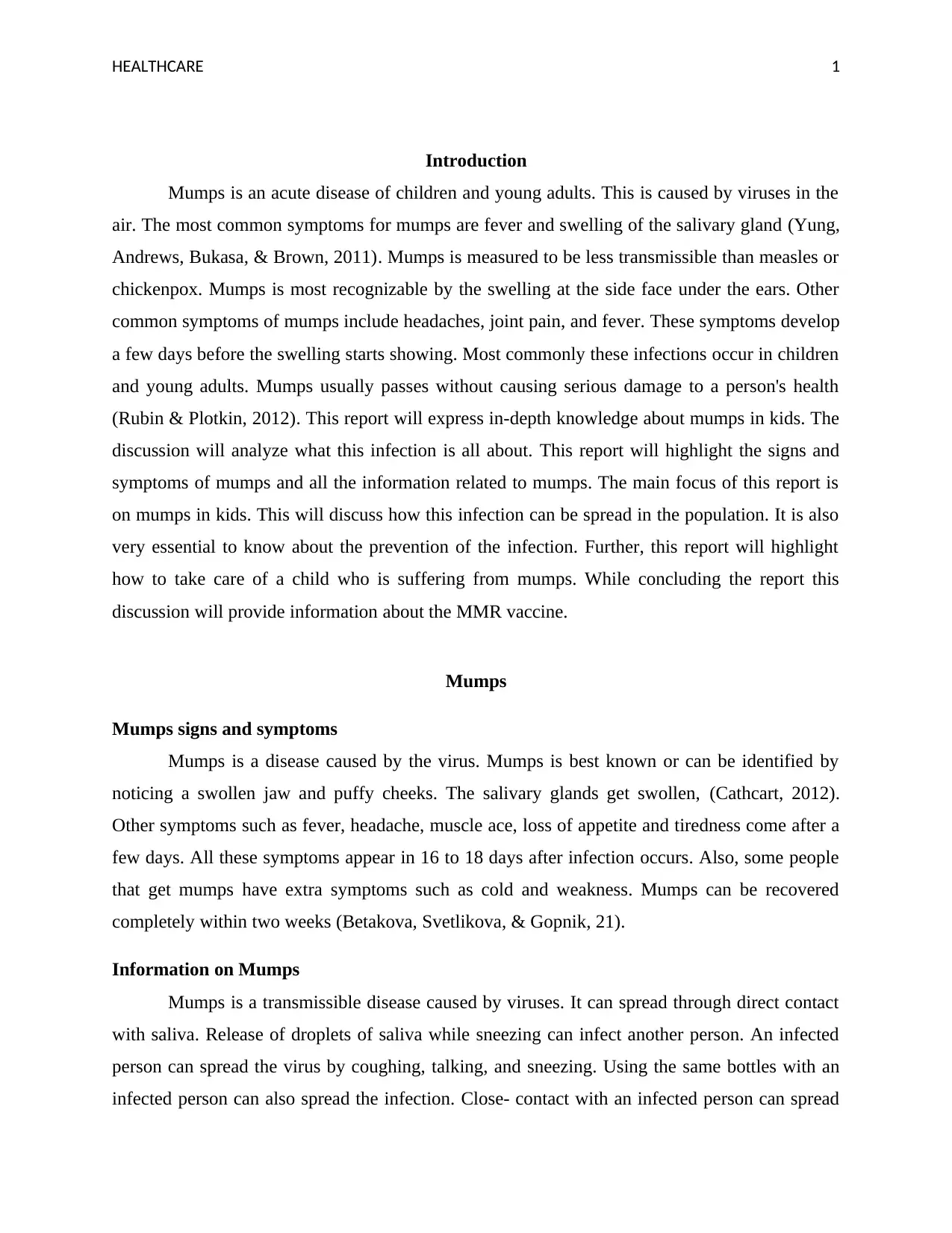
HEALTHCARE 1
Introduction
Mumps is an acute disease of children and young adults. This is caused by viruses in the
air. The most common symptoms for mumps are fever and swelling of the salivary gland (Yung,
Andrews, Bukasa, & Brown, 2011). Mumps is measured to be less transmissible than measles or
chickenpox. Mumps is most recognizable by the swelling at the side face under the ears. Other
common symptoms of mumps include headaches, joint pain, and fever. These symptoms develop
a few days before the swelling starts showing. Most commonly these infections occur in children
and young adults. Mumps usually passes without causing serious damage to a person's health
(Rubin & Plotkin, 2012). This report will express in-depth knowledge about mumps in kids. The
discussion will analyze what this infection is all about. This report will highlight the signs and
symptoms of mumps and all the information related to mumps. The main focus of this report is
on mumps in kids. This will discuss how this infection can be spread in the population. It is also
very essential to know about the prevention of the infection. Further, this report will highlight
how to take care of a child who is suffering from mumps. While concluding the report this
discussion will provide information about the MMR vaccine.
Mumps
Mumps signs and symptoms
Mumps is a disease caused by the virus. Mumps is best known or can be identified by
noticing a swollen jaw and puffy cheeks. The salivary glands get swollen, (Cathcart, 2012).
Other symptoms such as fever, headache, muscle ace, loss of appetite and tiredness come after a
few days. All these symptoms appear in 16 to 18 days after infection occurs. Also, some people
that get mumps have extra symptoms such as cold and weakness. Mumps can be recovered
completely within two weeks (Betakova, Svetlikova, & Gopnik, 21).
Information on Mumps
Mumps is a transmissible disease caused by viruses. It can spread through direct contact
with saliva. Release of droplets of saliva while sneezing can infect another person. An infected
person can spread the virus by coughing, talking, and sneezing. Using the same bottles with an
infected person can also spread the infection. Close- contact with an infected person can spread
Introduction
Mumps is an acute disease of children and young adults. This is caused by viruses in the
air. The most common symptoms for mumps are fever and swelling of the salivary gland (Yung,
Andrews, Bukasa, & Brown, 2011). Mumps is measured to be less transmissible than measles or
chickenpox. Mumps is most recognizable by the swelling at the side face under the ears. Other
common symptoms of mumps include headaches, joint pain, and fever. These symptoms develop
a few days before the swelling starts showing. Most commonly these infections occur in children
and young adults. Mumps usually passes without causing serious damage to a person's health
(Rubin & Plotkin, 2012). This report will express in-depth knowledge about mumps in kids. The
discussion will analyze what this infection is all about. This report will highlight the signs and
symptoms of mumps and all the information related to mumps. The main focus of this report is
on mumps in kids. This will discuss how this infection can be spread in the population. It is also
very essential to know about the prevention of the infection. Further, this report will highlight
how to take care of a child who is suffering from mumps. While concluding the report this
discussion will provide information about the MMR vaccine.
Mumps
Mumps signs and symptoms
Mumps is a disease caused by the virus. Mumps is best known or can be identified by
noticing a swollen jaw and puffy cheeks. The salivary glands get swollen, (Cathcart, 2012).
Other symptoms such as fever, headache, muscle ace, loss of appetite and tiredness come after a
few days. All these symptoms appear in 16 to 18 days after infection occurs. Also, some people
that get mumps have extra symptoms such as cold and weakness. Mumps can be recovered
completely within two weeks (Betakova, Svetlikova, & Gopnik, 21).
Information on Mumps
Mumps is a transmissible disease caused by viruses. It can spread through direct contact
with saliva. Release of droplets of saliva while sneezing can infect another person. An infected
person can spread the virus by coughing, talking, and sneezing. Using the same bottles with an
infected person can also spread the infection. Close- contact with an infected person can spread

HEALTHCARE 2
the disease. A person suffering from the infection should make special efforts to not touch
objects or food items with unwashed hands.
An infected person can spread mumps easily a few days before as well because glands
start swelling after a couple of days. A person infected with mumps should limit his or her
contact with another person. For example, if kids are infected they should stay at home till the
time they are completely recovered.
Mumps in kids
How the mumps virus spreads
Mumps spread through the air from one person to another. Kids catch viruses easily that
is the reason mumps in kids is a common disease. Mumps can also spread by touch most of the
kids get infected in school because of the vast presence of kids. Mumps can be diagnosed by
physically examining the kid (MacDonald, Hatchette, Elkout, & Sarwal, 2011). In a few specific
situations, doctors may also order blood tests or swabs from throat or nose to help confirm the
diagnosis.
Prevent mumps
Mumps infection can be prevented in kids through the MMR vaccine. Vaccination is
given to kids in two doses. The first dose of the vaccine is given soon after the child's first
birthday. The second dose is given before the child starts going to school. Mumps can occur to
the kids that have missed one of their dose or both doses of the vaccination (Brown, Long,
Ramsay, & Hudson, 2012). Also, kids who miss their booster shots can get infected easily.
Mumps can be prevented by keeping a check on hygiene. Kids should avoid visiting the hospital
if they are well and not suffering from any disease. Hospitals do take care of cleanliness but kids
have lesser immunity as compared to adults and they get infected easily.
Care for a child with mumps
Mumps takes at least one week to get cured and two weeks to completely disappear. Kids
can be supported by their parents and family. Kids that get affected with mumps feel inactive,
they lose their appetite, often get a fever, and also suffer from muscle pain.
the disease. A person suffering from the infection should make special efforts to not touch
objects or food items with unwashed hands.
An infected person can spread mumps easily a few days before as well because glands
start swelling after a couple of days. A person infected with mumps should limit his or her
contact with another person. For example, if kids are infected they should stay at home till the
time they are completely recovered.
Mumps in kids
How the mumps virus spreads
Mumps spread through the air from one person to another. Kids catch viruses easily that
is the reason mumps in kids is a common disease. Mumps can also spread by touch most of the
kids get infected in school because of the vast presence of kids. Mumps can be diagnosed by
physically examining the kid (MacDonald, Hatchette, Elkout, & Sarwal, 2011). In a few specific
situations, doctors may also order blood tests or swabs from throat or nose to help confirm the
diagnosis.
Prevent mumps
Mumps infection can be prevented in kids through the MMR vaccine. Vaccination is
given to kids in two doses. The first dose of the vaccine is given soon after the child's first
birthday. The second dose is given before the child starts going to school. Mumps can occur to
the kids that have missed one of their dose or both doses of the vaccination (Brown, Long,
Ramsay, & Hudson, 2012). Also, kids who miss their booster shots can get infected easily.
Mumps can be prevented by keeping a check on hygiene. Kids should avoid visiting the hospital
if they are well and not suffering from any disease. Hospitals do take care of cleanliness but kids
have lesser immunity as compared to adults and they get infected easily.
Care for a child with mumps
Mumps takes at least one week to get cured and two weeks to completely disappear. Kids
can be supported by their parents and family. Kids that get affected with mumps feel inactive,
they lose their appetite, often get a fever, and also suffer from muscle pain.
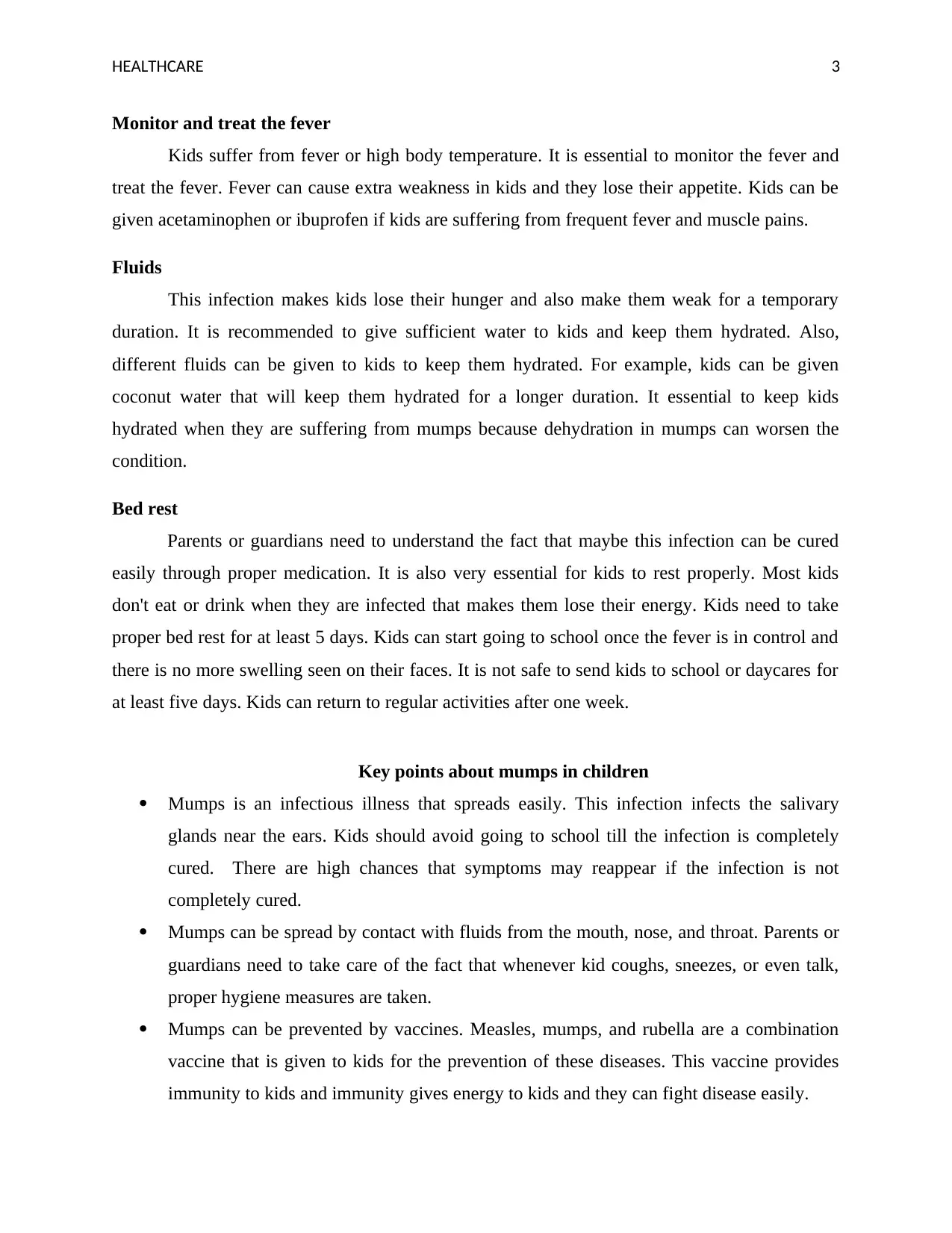
HEALTHCARE 3
Monitor and treat the fever
Kids suffer from fever or high body temperature. It is essential to monitor the fever and
treat the fever. Fever can cause extra weakness in kids and they lose their appetite. Kids can be
given acetaminophen or ibuprofen if kids are suffering from frequent fever and muscle pains.
Fluids
This infection makes kids lose their hunger and also make them weak for a temporary
duration. It is recommended to give sufficient water to kids and keep them hydrated. Also,
different fluids can be given to kids to keep them hydrated. For example, kids can be given
coconut water that will keep them hydrated for a longer duration. It essential to keep kids
hydrated when they are suffering from mumps because dehydration in mumps can worsen the
condition.
Bed rest
Parents or guardians need to understand the fact that maybe this infection can be cured
easily through proper medication. It is also very essential for kids to rest properly. Most kids
don't eat or drink when they are infected that makes them lose their energy. Kids need to take
proper bed rest for at least 5 days. Kids can start going to school once the fever is in control and
there is no more swelling seen on their faces. It is not safe to send kids to school or daycares for
at least five days. Kids can return to regular activities after one week.
Key points about mumps in children
Mumps is an infectious illness that spreads easily. This infection infects the salivary
glands near the ears. Kids should avoid going to school till the infection is completely
cured. There are high chances that symptoms may reappear if the infection is not
completely cured.
Mumps can be spread by contact with fluids from the mouth, nose, and throat. Parents or
guardians need to take care of the fact that whenever kid coughs, sneezes, or even talk,
proper hygiene measures are taken.
Mumps can be prevented by vaccines. Measles, mumps, and rubella are a combination
vaccine that is given to kids for the prevention of these diseases. This vaccine provides
immunity to kids and immunity gives energy to kids and they can fight disease easily.
Monitor and treat the fever
Kids suffer from fever or high body temperature. It is essential to monitor the fever and
treat the fever. Fever can cause extra weakness in kids and they lose their appetite. Kids can be
given acetaminophen or ibuprofen if kids are suffering from frequent fever and muscle pains.
Fluids
This infection makes kids lose their hunger and also make them weak for a temporary
duration. It is recommended to give sufficient water to kids and keep them hydrated. Also,
different fluids can be given to kids to keep them hydrated. For example, kids can be given
coconut water that will keep them hydrated for a longer duration. It essential to keep kids
hydrated when they are suffering from mumps because dehydration in mumps can worsen the
condition.
Bed rest
Parents or guardians need to understand the fact that maybe this infection can be cured
easily through proper medication. It is also very essential for kids to rest properly. Most kids
don't eat or drink when they are infected that makes them lose their energy. Kids need to take
proper bed rest for at least 5 days. Kids can start going to school once the fever is in control and
there is no more swelling seen on their faces. It is not safe to send kids to school or daycares for
at least five days. Kids can return to regular activities after one week.
Key points about mumps in children
Mumps is an infectious illness that spreads easily. This infection infects the salivary
glands near the ears. Kids should avoid going to school till the infection is completely
cured. There are high chances that symptoms may reappear if the infection is not
completely cured.
Mumps can be spread by contact with fluids from the mouth, nose, and throat. Parents or
guardians need to take care of the fact that whenever kid coughs, sneezes, or even talk,
proper hygiene measures are taken.
Mumps can be prevented by vaccines. Measles, mumps, and rubella are a combination
vaccine that is given to kids for the prevention of these diseases. This vaccine provides
immunity to kids and immunity gives energy to kids and they can fight disease easily.
Paraphrase This Document
Need a fresh take? Get an instant paraphrase of this document with our AI Paraphraser

HEALTHCARE 4
The common symptoms of mumps are swelling in salivary glands, fever, trouble in
chewing food, and earache because of swelling. The kids need to have a proper diet that
contains food that is easy to chew and lots of fluids to keep kids hydrated.
The medication course for this infection is easy and manageable. Treatment includes rest,
proper diet, and acetaminophen for uneasiness.
It is suggested by doctors to keep kids away from places that are populated. Kids should
maintain proper hygiene so that symptoms of infection go away easily.
Mumps in the UK
Mumps is infectious and causes health complications. It is essential to remove the myths
related to the disease and spread the correct information related to the disease to increase
awareness. Especially in kids, mumps is very common due to vast exposure to viruses and kids
with weak immunity get infected easily. UK has noticed a decline in the MMR vaccine that can
prevent kids from getting infected (England, 2018). The reason for the decline in the vaccine is
said to be the wrong and dangerous misinformation related to vaccines and booster shots.
In 2019 there was an increase in the number of patients with over 15000 cases reported.
When in comparison to 2018 there were only 6000 cases recorded (BBC, 2020). After this
increase in 2019 UK described the population that mumps can be prevented by having MMR
vaccine. To decrease the mumps infected cases it is essential for at least 95 % of people who
need to get vaccinated that includes all age groups.
MMR Vaccine
MMR is a safe and effective combined vaccine that protects from three highly infectious
diseases that are measles, mumps, and rubella. The full course of this vaccination requires two
doses (Demicheli, Rivetti, Debalini, & Pietrantonj, 2013). If these diseases are not treated in time
then it can get worse and show some serious complications such as meningitis, swelling of the
brain and even deafness. Since this vaccine was introduced in 1988 in the UK it is rare for kids to
reach these complications (Kowalzik, Faber, & Knuf, 2018).
The common symptoms of mumps are swelling in salivary glands, fever, trouble in
chewing food, and earache because of swelling. The kids need to have a proper diet that
contains food that is easy to chew and lots of fluids to keep kids hydrated.
The medication course for this infection is easy and manageable. Treatment includes rest,
proper diet, and acetaminophen for uneasiness.
It is suggested by doctors to keep kids away from places that are populated. Kids should
maintain proper hygiene so that symptoms of infection go away easily.
Mumps in the UK
Mumps is infectious and causes health complications. It is essential to remove the myths
related to the disease and spread the correct information related to the disease to increase
awareness. Especially in kids, mumps is very common due to vast exposure to viruses and kids
with weak immunity get infected easily. UK has noticed a decline in the MMR vaccine that can
prevent kids from getting infected (England, 2018). The reason for the decline in the vaccine is
said to be the wrong and dangerous misinformation related to vaccines and booster shots.
In 2019 there was an increase in the number of patients with over 15000 cases reported.
When in comparison to 2018 there were only 6000 cases recorded (BBC, 2020). After this
increase in 2019 UK described the population that mumps can be prevented by having MMR
vaccine. To decrease the mumps infected cases it is essential for at least 95 % of people who
need to get vaccinated that includes all age groups.
MMR Vaccine
MMR is a safe and effective combined vaccine that protects from three highly infectious
diseases that are measles, mumps, and rubella. The full course of this vaccination requires two
doses (Demicheli, Rivetti, Debalini, & Pietrantonj, 2013). If these diseases are not treated in time
then it can get worse and show some serious complications such as meningitis, swelling of the
brain and even deafness. Since this vaccine was introduced in 1988 in the UK it is rare for kids to
reach these complications (Kowalzik, Faber, & Knuf, 2018).
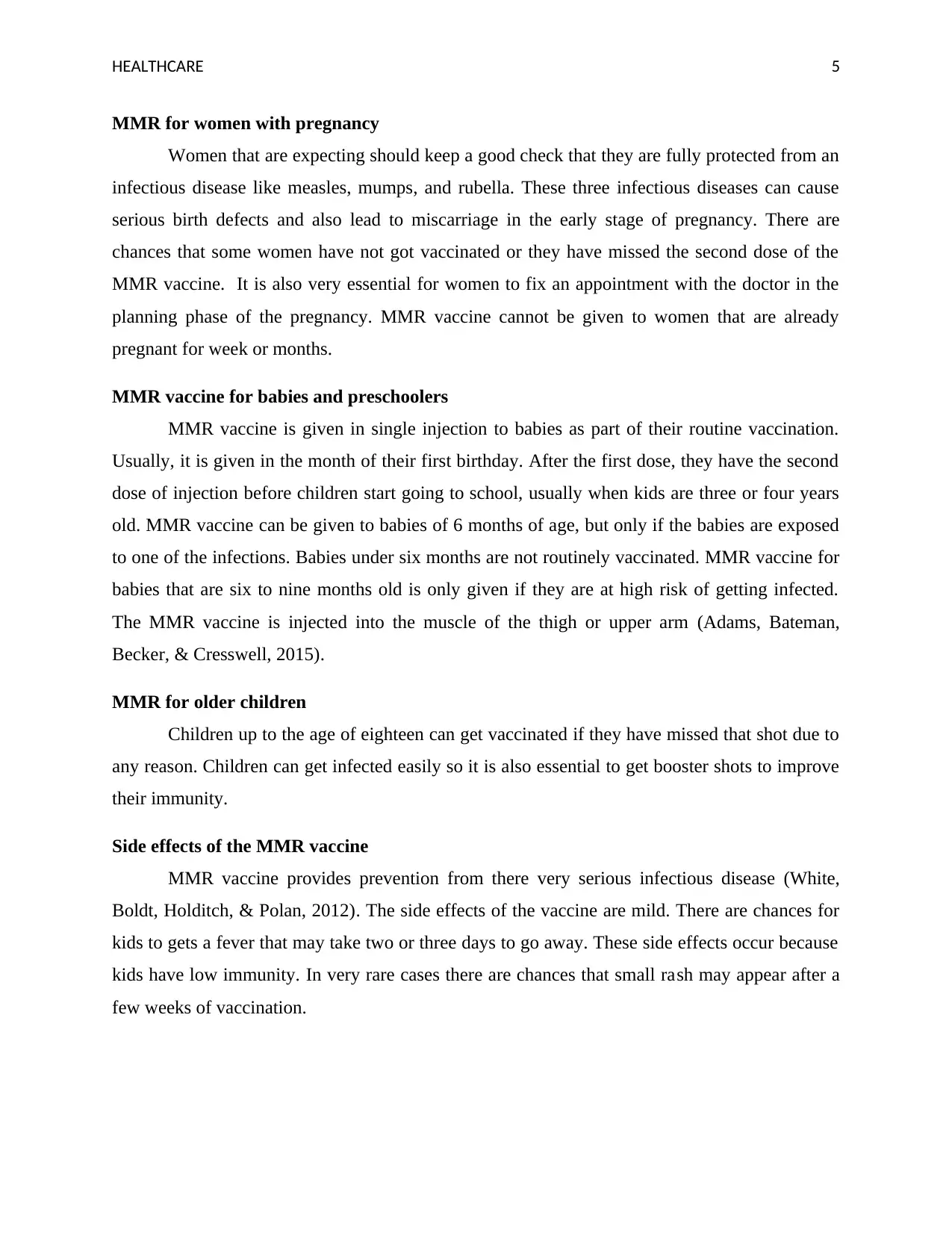
HEALTHCARE 5
MMR for women with pregnancy
Women that are expecting should keep a good check that they are fully protected from an
infectious disease like measles, mumps, and rubella. These three infectious diseases can cause
serious birth defects and also lead to miscarriage in the early stage of pregnancy. There are
chances that some women have not got vaccinated or they have missed the second dose of the
MMR vaccine. It is also very essential for women to fix an appointment with the doctor in the
planning phase of the pregnancy. MMR vaccine cannot be given to women that are already
pregnant for week or months.
MMR vaccine for babies and preschoolers
MMR vaccine is given in single injection to babies as part of their routine vaccination.
Usually, it is given in the month of their first birthday. After the first dose, they have the second
dose of injection before children start going to school, usually when kids are three or four years
old. MMR vaccine can be given to babies of 6 months of age, but only if the babies are exposed
to one of the infections. Babies under six months are not routinely vaccinated. MMR vaccine for
babies that are six to nine months old is only given if they are at high risk of getting infected.
The MMR vaccine is injected into the muscle of the thigh or upper arm (Adams, Bateman,
Becker, & Cresswell, 2015).
MMR for older children
Children up to the age of eighteen can get vaccinated if they have missed that shot due to
any reason. Children can get infected easily so it is also essential to get booster shots to improve
their immunity.
Side effects of the MMR vaccine
MMR vaccine provides prevention from there very serious infectious disease (White,
Boldt, Holditch, & Polan, 2012). The side effects of the vaccine are mild. There are chances for
kids to gets a fever that may take two or three days to go away. These side effects occur because
kids have low immunity. In very rare cases there are chances that small rash may appear after a
few weeks of vaccination.
MMR for women with pregnancy
Women that are expecting should keep a good check that they are fully protected from an
infectious disease like measles, mumps, and rubella. These three infectious diseases can cause
serious birth defects and also lead to miscarriage in the early stage of pregnancy. There are
chances that some women have not got vaccinated or they have missed the second dose of the
MMR vaccine. It is also very essential for women to fix an appointment with the doctor in the
planning phase of the pregnancy. MMR vaccine cannot be given to women that are already
pregnant for week or months.
MMR vaccine for babies and preschoolers
MMR vaccine is given in single injection to babies as part of their routine vaccination.
Usually, it is given in the month of their first birthday. After the first dose, they have the second
dose of injection before children start going to school, usually when kids are three or four years
old. MMR vaccine can be given to babies of 6 months of age, but only if the babies are exposed
to one of the infections. Babies under six months are not routinely vaccinated. MMR vaccine for
babies that are six to nine months old is only given if they are at high risk of getting infected.
The MMR vaccine is injected into the muscle of the thigh or upper arm (Adams, Bateman,
Becker, & Cresswell, 2015).
MMR for older children
Children up to the age of eighteen can get vaccinated if they have missed that shot due to
any reason. Children can get infected easily so it is also essential to get booster shots to improve
their immunity.
Side effects of the MMR vaccine
MMR vaccine provides prevention from there very serious infectious disease (White,
Boldt, Holditch, & Polan, 2012). The side effects of the vaccine are mild. There are chances for
kids to gets a fever that may take two or three days to go away. These side effects occur because
kids have low immunity. In very rare cases there are chances that small rash may appear after a
few weeks of vaccination.
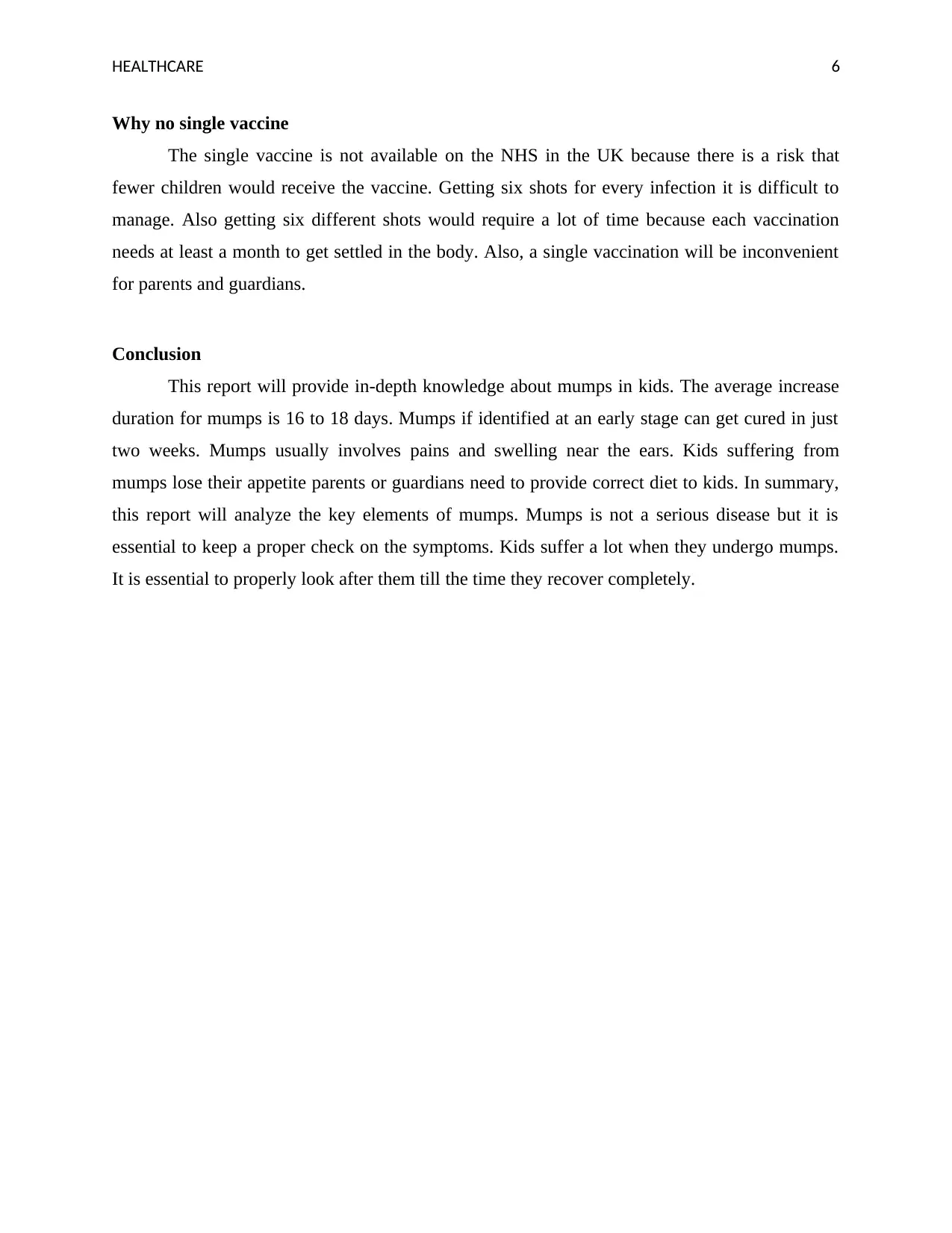
HEALTHCARE 6
Why no single vaccine
The single vaccine is not available on the NHS in the UK because there is a risk that
fewer children would receive the vaccine. Getting six shots for every infection it is difficult to
manage. Also getting six different shots would require a lot of time because each vaccination
needs at least a month to get settled in the body. Also, a single vaccination will be inconvenient
for parents and guardians.
Conclusion
This report will provide in-depth knowledge about mumps in kids. The average increase
duration for mumps is 16 to 18 days. Mumps if identified at an early stage can get cured in just
two weeks. Mumps usually involves pains and swelling near the ears. Kids suffering from
mumps lose their appetite parents or guardians need to provide correct diet to kids. In summary,
this report will analyze the key elements of mumps. Mumps is not a serious disease but it is
essential to keep a proper check on the symptoms. Kids suffer a lot when they undergo mumps.
It is essential to properly look after them till the time they recover completely.
Why no single vaccine
The single vaccine is not available on the NHS in the UK because there is a risk that
fewer children would receive the vaccine. Getting six shots for every infection it is difficult to
manage. Also getting six different shots would require a lot of time because each vaccination
needs at least a month to get settled in the body. Also, a single vaccination will be inconvenient
for parents and guardians.
Conclusion
This report will provide in-depth knowledge about mumps in kids. The average increase
duration for mumps is 16 to 18 days. Mumps if identified at an early stage can get cured in just
two weeks. Mumps usually involves pains and swelling near the ears. Kids suffering from
mumps lose their appetite parents or guardians need to provide correct diet to kids. In summary,
this report will analyze the key elements of mumps. Mumps is not a serious disease but it is
essential to keep a proper check on the symptoms. Kids suffer a lot when they undergo mumps.
It is essential to properly look after them till the time they recover completely.
Secure Best Marks with AI Grader
Need help grading? Try our AI Grader for instant feedback on your assignments.
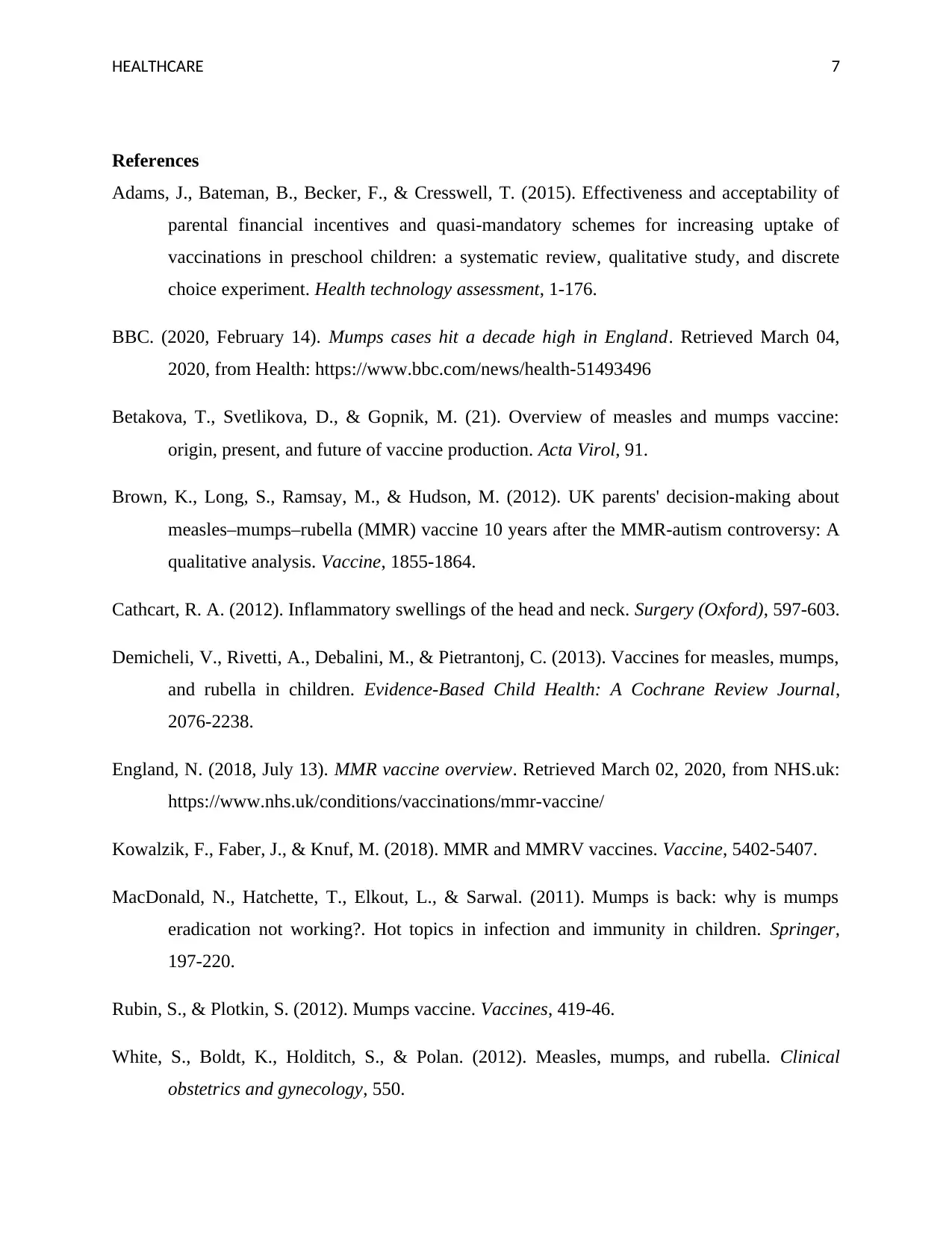
HEALTHCARE 7
References
Adams, J., Bateman, B., Becker, F., & Cresswell, T. (2015). Effectiveness and acceptability of
parental financial incentives and quasi-mandatory schemes for increasing uptake of
vaccinations in preschool children: a systematic review, qualitative study, and discrete
choice experiment. Health technology assessment, 1-176.
BBC. (2020, February 14). Mumps cases hit a decade high in England. Retrieved March 04,
2020, from Health: https://www.bbc.com/news/health-51493496
Betakova, T., Svetlikova, D., & Gopnik, M. (21). Overview of measles and mumps vaccine:
origin, present, and future of vaccine production. Acta Virol, 91.
Brown, K., Long, S., Ramsay, M., & Hudson, M. (2012). UK parents' decision-making about
measles–mumps–rubella (MMR) vaccine 10 years after the MMR-autism controversy: A
qualitative analysis. Vaccine, 1855-1864.
Cathcart, R. A. (2012). Inflammatory swellings of the head and neck. Surgery (Oxford), 597-603.
Demicheli, V., Rivetti, A., Debalini, M., & Pietrantonj, C. (2013). Vaccines for measles, mumps,
and rubella in children. Evidence‐Based Child Health: A Cochrane Review Journal,
2076-2238.
England, N. (2018, July 13). MMR vaccine overview. Retrieved March 02, 2020, from NHS.uk:
https://www.nhs.uk/conditions/vaccinations/mmr-vaccine/
Kowalzik, F., Faber, J., & Knuf, M. (2018). MMR and MMRV vaccines. Vaccine, 5402-5407.
MacDonald, N., Hatchette, T., Elkout, L., & Sarwal. (2011). Mumps is back: why is mumps
eradication not working?. Hot topics in infection and immunity in children. Springer,
197-220.
Rubin, S., & Plotkin, S. (2012). Mumps vaccine. Vaccines, 419-46.
White, S., Boldt, K., Holditch, S., & Polan. (2012). Measles, mumps, and rubella. Clinical
obstetrics and gynecology, 550.
References
Adams, J., Bateman, B., Becker, F., & Cresswell, T. (2015). Effectiveness and acceptability of
parental financial incentives and quasi-mandatory schemes for increasing uptake of
vaccinations in preschool children: a systematic review, qualitative study, and discrete
choice experiment. Health technology assessment, 1-176.
BBC. (2020, February 14). Mumps cases hit a decade high in England. Retrieved March 04,
2020, from Health: https://www.bbc.com/news/health-51493496
Betakova, T., Svetlikova, D., & Gopnik, M. (21). Overview of measles and mumps vaccine:
origin, present, and future of vaccine production. Acta Virol, 91.
Brown, K., Long, S., Ramsay, M., & Hudson, M. (2012). UK parents' decision-making about
measles–mumps–rubella (MMR) vaccine 10 years after the MMR-autism controversy: A
qualitative analysis. Vaccine, 1855-1864.
Cathcart, R. A. (2012). Inflammatory swellings of the head and neck. Surgery (Oxford), 597-603.
Demicheli, V., Rivetti, A., Debalini, M., & Pietrantonj, C. (2013). Vaccines for measles, mumps,
and rubella in children. Evidence‐Based Child Health: A Cochrane Review Journal,
2076-2238.
England, N. (2018, July 13). MMR vaccine overview. Retrieved March 02, 2020, from NHS.uk:
https://www.nhs.uk/conditions/vaccinations/mmr-vaccine/
Kowalzik, F., Faber, J., & Knuf, M. (2018). MMR and MMRV vaccines. Vaccine, 5402-5407.
MacDonald, N., Hatchette, T., Elkout, L., & Sarwal. (2011). Mumps is back: why is mumps
eradication not working?. Hot topics in infection and immunity in children. Springer,
197-220.
Rubin, S., & Plotkin, S. (2012). Mumps vaccine. Vaccines, 419-46.
White, S., Boldt, K., Holditch, S., & Polan. (2012). Measles, mumps, and rubella. Clinical
obstetrics and gynecology, 550.

HEALTHCARE 8
Yung, C., Andrews, N., Bukasa, A., & Brown, K. (2011). Mumps complications and effects of
mumps vaccination, England and Wales, Emerging infectious diseases, 661.
Yung, C., Andrews, N., Bukasa, A., & Brown, K. (2011). Mumps complications and effects of
mumps vaccination, England and Wales, Emerging infectious diseases, 661.
1 out of 9
![[object Object]](/_next/static/media/star-bottom.7253800d.svg)





